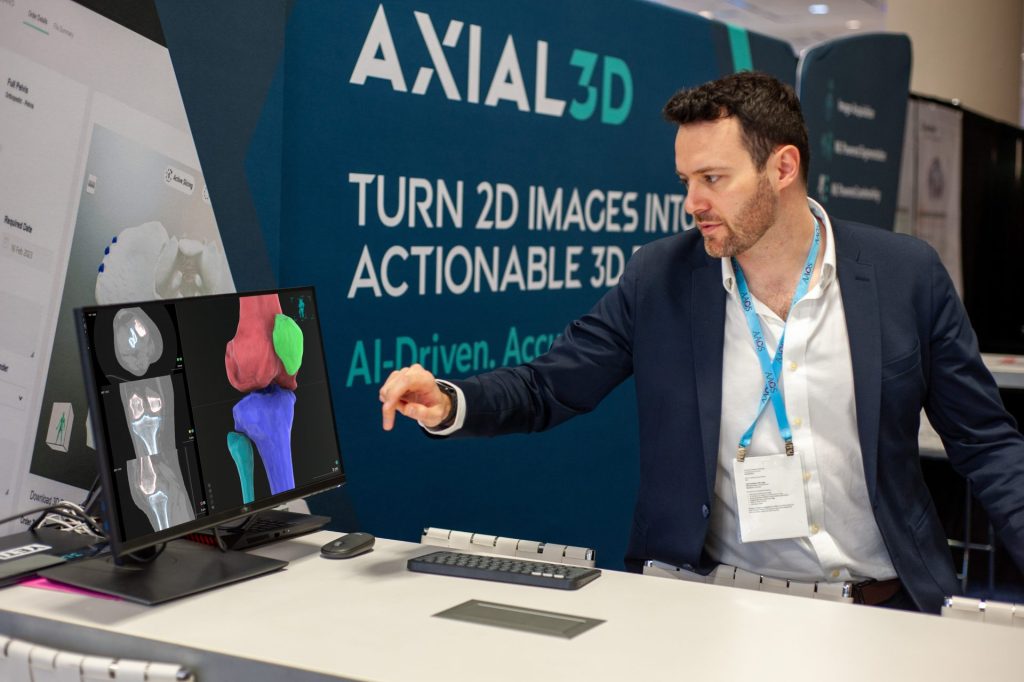In an industry racing toward personalized care, medical device companies are often held back by legacy systems, resource constraints, and manual workflows that slow time-to-patient. That’s exactly why Axial3D created AXCEL—a customizable, AI-powered, cloud-based software platform designed specifically for the unique needs of device manufacturers. We sat down with Dan Crawford, Founder of Axial3D, to talk about why AXCEL is different, and how it’s helping companies deliver patient-specific solutions at scale.
Q1: Why did you create AXCEL specifically for medical device companies?
Dan: We kept hearing the same pain points from device companies: getting from scan to patient-ready product and plan was taking too long. Teams were juggling multiple desktop based tools, relying heavily on manual segmentation, and struggling to scale without adding headcount. AXCEL was built as a direct response to that. It’s not a one-size-fits-all tool—it’s a bespoke platform with components that adapt to each company’s specific workflow, product line, and regulatory needs.

It also builds on years of development from our INSIGHT cloud-based platform, originally developed for hospitals and surgical teams. With AXCEL, we took everything we learned from that—including AI automation, medical imaging expertise, and cloud-based collaboration—and evolved it into a solution purpose-built for the complex demands of medical device companies. Our goal was to reduce time-to-patient while increasing accuracy and efficiency across the board.
Q2: What challenges are medical device companies facing that AXCEL helps solve?
Dan: There are three major ones:
- Time-to-patient – Manual segmentation, planning workflows, long processing queues and back-and-forth approvals slow everything down.
- Limited resources – Many teams are small and stretched thin, yet expected to handle increasing volumes.
- Outdated workflows – A lot of companies are still using legacy systems that weren’t built for scaled personalized medicine. Sometimes there are numerous stand-alone processes and programs that are not integrated.
AXCEL addresses all of this by automating key parts of the workflow with AI, centralizing collaboration in one secure place, and tailoring the cloud-based platform to the company’s exact needs. That means fewer delays, less manual work, and faster delivery of patient-specific devices.
Q3: What makes AXCEL different from other platforms?
Dan: AXCEL isn’t an off-the-shelf tool. It’s a custom-built solution, its is configured for each partner, the reason being, everyone’s device and plan is different and for AI Automation to be a part of scaling workflows they need to be tailored to suit. We work closely with every device company to integrate AXCEL into their product development and surgical planning workflow—whether they’re producing implants, guides, surgical plans for robotic systems, or planning models. We also ensure the platform supports their quality system and regulatory requirements. It’s built to scale with them, not force them to adapt.
Compared to manual or even semi-automated solutions, AXCEL is in a different league. Manual segmentation is slow and inconsistent. Semi-automated tools still require heavy oversight, often from highly specialized staff. AXCEL uses advanced AI to deliver consistent, high-quality segmentation with minimal human input, and then wraps that into a full, end-to-end workflow that includes collaboration, validation, and compliance. It’s the difference between patching together independent tools and having one platform with modular elements designed to power personalized care at scale.
Q4: How does AXCEL impact efficiency and scalability?
Dan: A lot of medical device companies want to scale their personalized device offerings, but they’re running into operational bottlenecks. In many cases, the current workflow looks something like this: a scan comes in, it’s manually segmented by a skilled engineer, the model is sent for review, changes are requested, and only then can the next case begin. It’s essentially a “one case in, one case out” system—and that just doesn’t scale.
AXCEL completely changes that dynamic. By automating segmentation and planning workflows with AI, we shrink what used to take hours and days down to minutes, and that happens in parallel across multiple cases. Teams can process more cases simultaneously, without waiting on one to finish before starting the next. It also centralizes collaboration, so engineers, clinical specialists, and surgeons can work together in real time—reviewing, approving, and iterating all within the same platform.
The result? More throughput, faster delivery, and greater consistency—without needing to hire additional staff or overhaul internal systems. AXCEL frees companies from the linear, resource-heavy workflows and enables them to scale patient-specific solutions with confidence.
Q5: What’s the long-term vision for AXCEL in the medtech space?
Dan: We want AXCEL to be the engine of personalized care at scale. Device companies shouldn’t have to choose between quality and speed. With AXCEL, they don’t have to. They get a platform that’s customized to their business, optimized for patient-specific workflows, and built to grow with them. Ultimately, it means faster access to life-changing devices for the patients who need them most.



